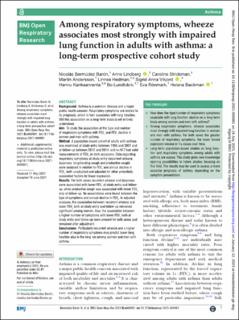| dc.contributor.author | Bermúdez Barón, Nicolás | |
| dc.contributor.author | Lindberg, Anne | |
| dc.contributor.author | Stridsman, Caroline | |
| dc.contributor.author | Andersson, Martin | |
| dc.contributor.author | Hedman, Linnea | |
| dc.contributor.author | Vikjord, Sigrid Anna Aalberg | |
| dc.contributor.author | Kankaanranta, Hannu | |
| dc.contributor.author | Lundbäck, Bo | |
| dc.contributor.author | Rönmark, Eva | |
| dc.contributor.author | Backman, Helena | |
| dc.date.accessioned | 2023-01-13T09:56:57Z | |
| dc.date.available | 2023-01-13T09:56:57Z | |
| dc.date.created | 2021-12-20T12:43:31Z | |
| dc.date.issued | 2021 | |
| dc.identifier.citation | BMJ Open Respiratory Research. 2021, 8 (1), . | en_US |
| dc.identifier.issn | 2052-4439 | |
| dc.identifier.uri | https://hdl.handle.net/11250/3043288 | |
| dc.description.abstract | Background Asthma is a common disease and a major public health concern. Respiratory symptoms are related to its prognosis, which in turn associates with lung function. Still this association on a long-term basis is not entirely understood.
Aim To study the association of the type and number of respiratory symptoms with FEV1 and FEV1 decline in women and men with asthma.
Method A population-based cohort of adults with asthma was examined at study entry between 1986 and 2001 and at follow-up between 2012 and 2014, and n=977 had valid measurements of FEV1 on both occasions. Data regarding respiratory symptoms at study entry (recurrent wheeze, dyspnoea, longstanding cough and productive cough) were analysed in relation to FEV1 and annual decline in FEV1, both unadjusted and adjusted for other potentially associated factors by linear regression.
Results For both sexes recurrent wheeze and dyspnoea were associated with lower FEV1 at study entry and follow-up, while productive cough was associated with lower FEV1 only at follow-up. No associations were found between the type of symptoms and annual decline in FEV1. In adjusted analyses, the association between recurrent wheeze and lower FEV1 both at study entry and follow-up remained significant among women. Also, the association between a higher number of symptoms with lower FEV1 both at study entry and follow-up were present for both sexes and remained after adjustment.
Conclusions Particularly recurrent wheeze and a higher number of respiratory symptoms may predict lower lung function also in the long run among women and men with asthma. | en_US |
| dc.language.iso | eng | en_US |
| dc.publisher | BMJ Publishing Group | en_US |
| dc.rights | Navngivelse 4.0 Internasjonal | * |
| dc.rights.uri | http://creativecommons.org/licenses/by/4.0/deed.no | * |
| dc.title | Among respiratory symptoms, wheeze associates most strongly with impaired lung function in adults with asthma: A long-term prospective cohort study | en_US |
| dc.title.alternative | Among respiratory symptoms, wheeze associates most strongly with impaired lung function in adults with asthma: A long-term prospective cohort study | en_US |
| dc.type | Peer reviewed | en_US |
| dc.type | Journal article | en_US |
| dc.description.version | publishedVersion | en_US |
| dc.source.pagenumber | 0 | en_US |
| dc.source.volume | 8 | en_US |
| dc.source.journal | BMJ Open Respiratory Research | en_US |
| dc.source.issue | 1 | en_US |
| dc.identifier.doi | 10.1136/bmjresp-2021-000981 | |
| dc.identifier.cristin | 1970526 | |
| cristin.ispublished | true | |
| cristin.fulltext | original | |
| cristin.qualitycode | 1 | |

